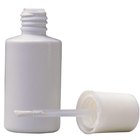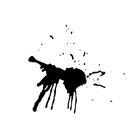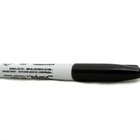
George Doyle/Stockbyte/Getty Images
When working with paint, it's always best to wear old clothes. However, if you somehow get paint on clothing that you love, try to remove the paint so you can wear the item again. Wet paint is easier to remove from clothing than dry paint, so act quickly for best results.
Identify the Type of Paint
As soon as you notice that you have gotten paint on a piece of clothing, read the paint can to identify the type of paint. Water-based paint, such as acrylic and latex, can usually be washed and removed with water. Oil-based paints are much harder to remove, and they will probably require a heavy-duty paint remover.
Removing Wet Water-Based Paint
Begin by removing any excess paint using a spoon or knife, taking care not to spread the paint around. From the back of the fabric, run warm water over the stain to remove as much paint as possible. Once the water begins to run clear, remove the garment and gently sponge the front of the stain with a mixture of 1-part warm water to 1-part laundry detergent. Rinse and repeat as many times as necessary. Once you've removed the stain, launder as usual.
Removing Dry Water-Based Paint
Begin by scraping off as much dried paint as you can using a dull knife or a brush. As with wet paint, gently sponge the front of the stain with a mixture of 1-part warm water to 1-part laundry detergent. Rinse and repeat as many times as necessary. If warm water and laundry detergent do not succeed in removing the stain, however, blot the stain with rubbing alcohol on an absorbent cloth or cotton pad. Be sure to test the rubbing alcohol on an inconspicuous area of the fabric before you begin. Repeat until the stain is removed, and launder as usual.
Removing Wet Oil-Based Paint
Begin by reading the can of paint; it may contain information as to a suggested paint remover and recommend the ideal stain-removal process. Remove as much of the wet paint as possible using the edge of a plastic spoon or knife. Place the fabric stain-side down on top of an absorbent cloth or towel. Using a sponge or cloth, blot -- don't rub -- the stain with the suggested paint remover or turpentine. Always test the paint remover on an inconspicuous area of the fabric before you begin. As soon as the cloth underneath the garment is wet, replace it so that you don’t spread the paint back into the garment. Once you have blotted away as much of the stain as possible, gently rub some laundry detergent into the stain. If it's OK for the type of fabric, soak the garment in hot water overnight; then launder as usual.
Removing Dry Oil-Based Paint
Begin by scraping off as much dried paint as you can using a dull knife or brush. Place the garment on a clean towel, and blot the stain using the paint remover recommended on your can of paint, or an alternative such as turpentine or paint thinner. Remember to always test the paint removal agent first on a part of the garment that is hidden, and replace the towel underneath as soon as it becomes damp. After blotting away as much of the stain as possible, rub a small amount of laundry soap into the stain and launder as usual. Oil-based paint is even more difficult to remove when dry, so be aware that you may not be able to completely eliminate the stain in your garment.
Related Articles

How to Remove Tempera Paint From Your ...

How to Get Paint Stains Out of Clothes

How to Remove Crayola Paint From ...

How to Get Grease Stains Out of ...

How to Remove Water Based Paint From ...

How to Get Paint Off Leggings

How to Remove Blue Jean Dye Stains from ...

How to Remove Bic White Out From Fabric

How to Remove Ballpoint Pen Ink Marks ...

How to Remove Lye Stains

How Do I Get Acrylic Paint Out of a ...

How to Remove Permanent Marker From ...

How to Remove Sharpie Ink From Clothing

How to Get a Wet Erase Marker off of ...

How to Remove Paint Stain From a Polar ...

How to Remove Sweat & Deodorant Stains ...

How to Clean Paint Off a Velvet Jacket

How to Remove Tempera Paint From Your ...

How to Get Paint Off of Your Uggs

How to Get Ink Out of Clothes With ...
References
Writer Bio
Elya Lam is a professional writer and certified home economics teacher, who loves all things crafty! Based in Saskatchewan, Canada, she has developed curricula for the Saskatchewan 4-H Council.
Photo Credits
George Doyle/Stockbyte/Getty Images